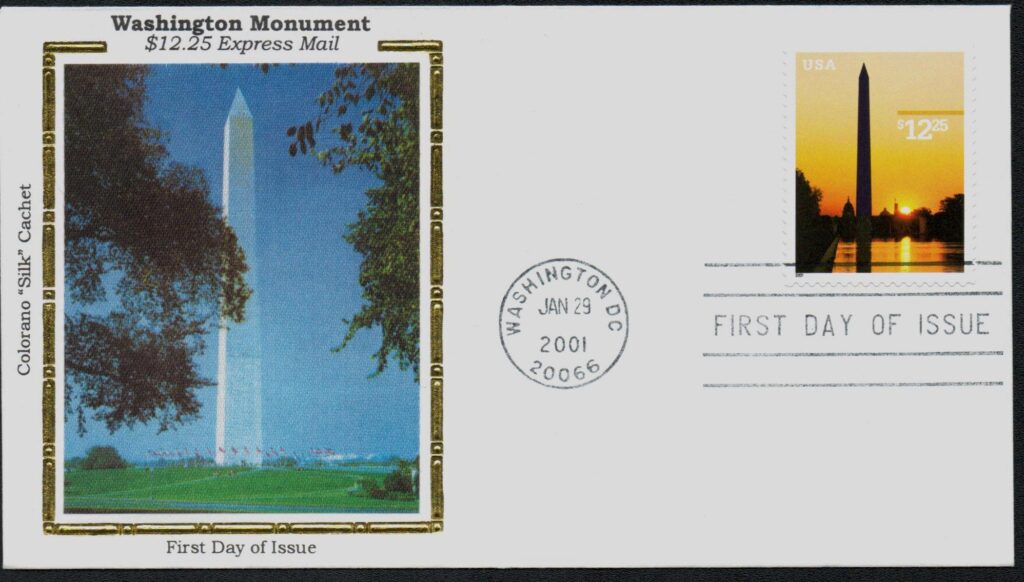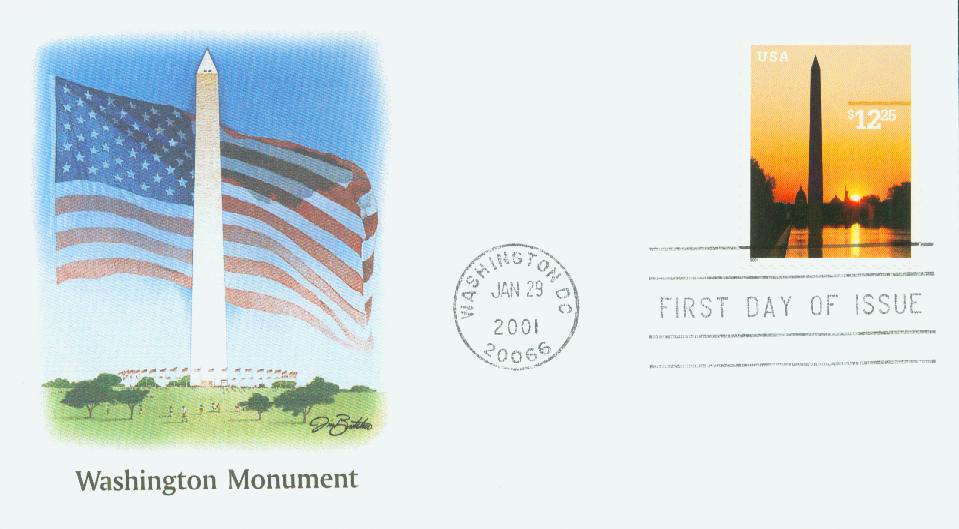On February 21, 1885, the Washington Monument was dedicated, 37 years after its cornerstone was laid.
In his lifetime, George Washington was a revered and respected man. Unanimously elected the first president of the United States, he created a national bank, collected taxes to cover expenses, and improved the Army and Navy. He even turned down a salary, only accepting money to cover his expenses. Washington was so popular in fact; that the people tried to get him to serve a third term, but the noble leader chose instead to retire to his peaceful Mount Vernon home.
When Washington died two years later, the people of America wanted to honor him. Within 10 days of the president’s death, John Marshall of Virginia suggested the creation of a tomb in the Capitol. However, there was no money for the project and Washington’s family refused to move his body.
Finally, in 1832, the 100th anniversary of Washington’s birth, a group of citizens formed the Washington National Monument Society. Within the first few years, they raised more than $28,000 and announced a competition to select the memorial design.
According to the board of managers, “It proposed that the contemplated monument shall be like him in whose honor it is to be constructed, unparalleled in the world, and commensurate with gratitude, liberality, and patriotism of the people by whom it is erected… It should blend stupendousness with elegance, and be of such magnitude and beauty as to be an object of pride to the American people, and of admiration to all who see it.”
The winning design, created by architect Robert Mills, called for a 600-foot obelisk (a tall, four-sided pillar that tapers near the top). Mills’s design also called for the obelisk to be surrounded by a circular colonnade topped with a statue of Washington in a chariot. Within the colonnade would be the statues of 30 notable Revolutionary War heroes. Many criticized the design and its $1 million proposed cost. The society decided to start building the obelisk and worry about whether or not to build the colonnade later. They believed that if they used the $87,000 they’d already raised, the progress on the monument would inspire more donations.
When Pierre L’Enfant created his plans for Washington, DC in 1791, he included a spot for an equestrian statue of Washington. However, after the design was selected, planners realized that the intended spot was too swampy and unstable to support such a massive and heavy structure. They then selected a new spot slightly southeast of the original with a “beautiful view of the Potomac and is “so elevated that the monument will be seen from all parts of the surrounding country.”
Excavation for the foundation began in the spring of 1848, with the cornerstone laid that July 4th in an elaborate ceremony hosted by the Freemasons. Construction on the monument continued until 1854 when all the donations had been spent. The following year Congress planned to give $200,000 to the project, but then changed its mind. The change was because of the Society’s decision to encourage the states and territories to donate memorial stones to fill in the monument’s inner walls. Native American tribes, professional organizations, businesses, and foreign countries donated these stones.
One stone, donated by Pope Pius IX, was actually stolen by an anti-Catholic group, and supposedly thrown in the Potomac River in 1854. This anti-immigrant group, known as the “Know-Nothings” then staged a fraudulent election so they could take over control of the Washington Monument Society, so it could fit their beliefs. However, they were unable to raise enough money to complete the monument and eventually returned control back to the original group.
However, the Civil War erupted shortly after, and once again construction was halted. There was renewed interest in the monument after the war and in 1876, the 100th anniversary of the Declaration of Independence, Congress gave $200,000 to finish the monument. During this time, talks over how to complete the monument resumed. Many still opposed Mills’s colonnade design, so a new design competition was held. Ultimately, the society selected a design by William Wetmore Story – an obelisk similar to classical Egyptian proportions and no colonnade. Construction finally resumed in 1879. The foundation was redesigned so it could support a 40,000-ton structure. The Army Corps of Engineers worked quickly – they built over two-thirds of the monument in just a few years.
After 36 years of construction, debates, and work stoppages, the monument was finally completed on December 6, 1884. In an elaborate dedication ceremony, the 3,300-pound marble capstone was put into place along with a 100-ounce aluminum apex/lightning rod. This apex was the largest piece of aluminum cast at the time.
The monument was officially dedicated on February 21, 1885. President Chester Arthur gave a speech as one of his final acts as president. He declared the monument “dedicated from this time forth to the immortal name and memory of George Washington.” The day’s events included several speeches, a parade down Pennsylvania Avenue, fireworks, and ground and aerial displays.
At just over 555 feet, the Washington Monument was the tallest structure in the world when it was completed, surpassing the Cologne Cathedral. However, it was later surpassed by the Eiffel Tower in 1889. Today it is still the world’s tallest stone structure and tallest obelisk. Over 800,000 visitors a year either take an elevator to the top of the monument or climb the iron stairway.
Did You Know?
There’s a 12-foot-tall replica of the Washington Monument in a manhole a few feet from the real monument. Created in the 1880s, the miniature monument (known as Bench Mark A) is a Geodetic Control Point. Surveyors use millions of these across the country to manage national maps. Measurements taken over the last 100 years have shown that the soft ground under the monument has risen 6.2 centimeters over time. Click here for photos and more about the mini monument.
Click here for more about the monument from the National Park Service.
| FREE printable This Day in History album pages Download a PDF of today’s article. Get a binder or other supplies to create your This Day in History album. |
Discover what else happened on This Day in History.









Thank you for terrific recounting of the building of Washington’s Monument! I did not know one could still climb up to the top. I wonder how they were able to place the top on it without cranes?? Scaffolding??
I visited the Washington Monument as a young child. I had no idea of the background of this structure.
Thanks for the wonderful history lesson!
Washington still the only President elected unanimously by Electoral College. Monroe refused to be re-elected unanimously in 1821 out of deference to Washington.